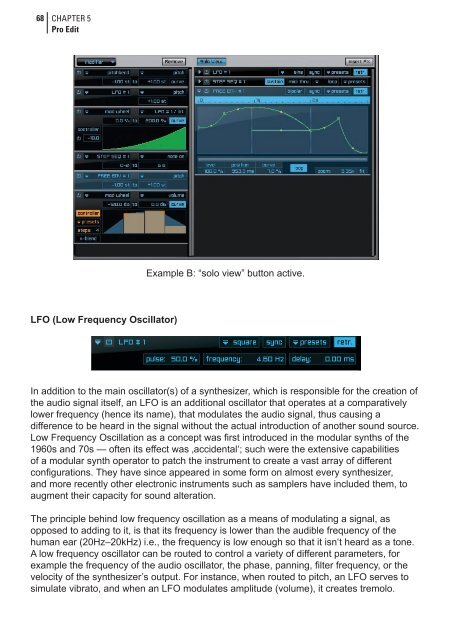Create successful ePaper yourself
Turn your PDF publications into a flip-book with our unique Google optimized e-Paper software.
68<br />
CHAPTER 5<br />
Pro Edit<br />
LFO (Low Frequency Oscillator)<br />
Example B: “solo view” button active.<br />
In addition to the main oscillator(s) of a synthesizer, which is responsible for the creation of<br />
the audio signal itself, an LFO is an additional oscillator that operates at a comparatively<br />
lower frequency (hence its name), that modulates the audio signal, thus causing a<br />
difference to be heard in the signal without the actual introduction of another sound source.<br />
Low Frequency Oscillation as a concept was first introduced in the modular synths of the<br />
1960s and 70s — often its effect was ‚accidental‘; such were the extensive capabilities<br />
of a modular synth operator to patch the instrument to create a vast array of different<br />
configurations. They have since appeared in some form on almost every synthesizer,<br />
and more recently other electronic instruments such as samplers have included them, to<br />
augment their capacity for sound alteration.<br />
The principle behind low frequency oscillation as a means of modulating a signal, as<br />
opposed to adding to it, is that its frequency is lower than the audible frequency of the<br />
human ear (20Hz–20kHz) i.e., the frequency is low enough so that it isn‘t heard as a tone.<br />
A low frequency oscillator can be routed to control a variety of different parameters, for<br />
example the frequency of the audio oscillator, the phase, panning, filter frequency, or the<br />
velocity of the synthesizer’s output. For instance, when routed to pitch, an LFO serves to<br />
simulate vibrato, and when an LFO modulates amplitude (volume), it creates tremolo.

















